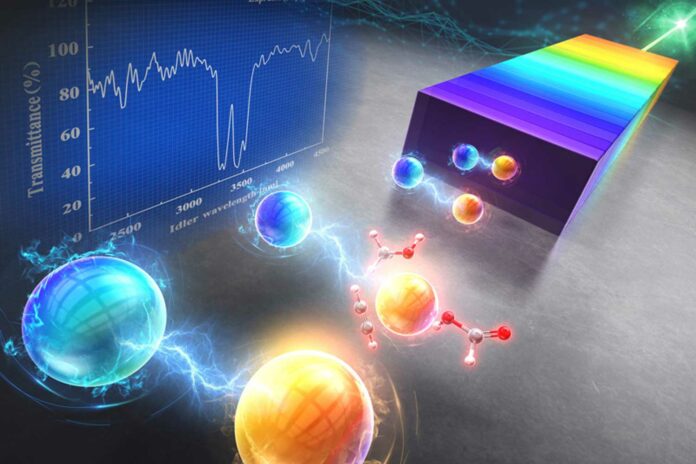Mid-infrared spectroscopy is crucial for identifying molecules in physics, chemistry, and medical sciences. Yet, obstacles like traditional infrared light sources, detectors, and blackbody radiation noise hinder miniaturization and sensitivity of infrared spectrometers. Quantum infrared spectroscopy offers a promising solution. It utilizes entangled photon pairs in the visible and infrared range, providing a new sensing technology that allows infrared spectroscopy with detectors in the visible range, overcoming previous limitations.
However, the bandwidth of conventional quantum entangled light sources is at most 1 µm or less, which hinders broadband measurements, which are essential in spectroscopic applications.
A Kyoto University-led research team tackled the challenges in infrared spectroscopy by introducing a quantum light source. Their groundbreaking ultra-broadband, quantum-entangled source generates a broader range of infrared photons (2 μm to 5 μm wavelengths).
Shigeki Takeuchi of the Department of Electronic Science and Engineering emphasizes that this achievement opens the door to significantly downsizing systems and enhancing infrared spectrometer sensitivity.
The researchers envision a future where their compact, high-performance, battery-operated scanners will replace cumbersome and power-hungry equipment, facilitating on-site material testing in various fields like environmental monitoring, medicine, and security.
Takeuchi said, “We can obtain spectra for various target samples, including hard solids, plastics, and organic solutions. Shimadzu Corporation — our partner that developed the quantum light device — has concurred that the broadband measurement spectra were very convincing for distinguishing substances for a wide range of samples.”
While quantum-entangled light is not a new concept, its bandwidth in the infrared region is typically limited to a narrow range of 1 μm or less. The innovation in this technique lies in leveraging the unique properties of quantum mechanics, such as superposition and entanglement, to overcome the constraints of traditional methods.
The research team introduced an independently developed chirped quasi-phase-matching device to generate quantum-entangled light. This device utilizes chirping, the gradual change in an element’s polarization reversal period, to produce quantum photon pairs across a broad bandwidth.
The goal is to enhance the sensitivity of quantum infrared spectroscopy and advance quantum imaging in the infrared region as part of the team’s broader efforts to develop practical quantum technologies.
Journal Reference:
- Toshiyuki Tashima, Yu Mukai, Masaya Arahata, Norihide Oda, Mamoru Hisamitsu, Katsuhiko Tokuda, Ryo Okamoto, Shigeki Takeuchi (2024). Ultra-broadband quantum infrared spectroscopy. Optica, 11(1), 81-87. DOI: 10.1364/OPTICA.504450
